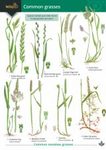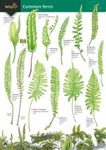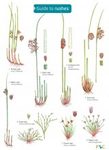Flora / Fauna Identification Key
By: Rémy Prelli(Author), Michel Boudrie(Author), Germinal Rouhan(Preface By)
528 pages, colour photos, colour distribution maps, tables
![Les Fougères et Plantes Alliées d'Europe [Ferns and Allied Plants of Europe] Les Fougères et Plantes Alliées d'Europe [Ferns and Allied Plants of Europe]]()
Click to have a closer look
About this book
Customer reviews
Related titles
About this book
Language: French
In the distant geological past, ferns played a fundamental role in the evolution of the living world. As the first plants to have really adapted to the terrestrial environment in the first half of the primary era (with a peak in the Carboniferous, 300 million years ago), they have continued, thereafter, to perfect their anatomical organization and their cycle of development, giving rise to the first forms of flowering plants.
This book is a new edition of a work by the same authors, published by Belin Editions in 2002. The content has been completely updated for the 165 species of European ferns, including their biology, ecology, and distribution. The book reports important taxonomic updates, in particular on the question of phylogeny and hybrids (64 hybrids are currently identified in Europe), reflecting the significance of the hybridization process as an important mechanism in the appearance of new species.
This encyclopaedic book is also intended to be a practical work and includes identification keys to species level. The entries are well-illustrated and useful not only for species recognition but provide an attractive feature of the book. A chapter is dedicated to the chorology of ferns in France, including the distribution of each species on departmental maps. The rarity and protection status and the threat factors are also detailed for each species.
Summary in French:
Dans un lointain passé géologique, les fougères ont joué un rôle fondamental dans l’évolution du monde vivant. Premières plantes à s’être vraiment adaptées au milieu terrestre dans la première moitié de l’ère primaire (avec une apogée au Carbonifère, il y a 300 millions d’années), elles n’ont cessé, par la suite, de perfectionner leur organisation anatomique et leur cycle de développement, en donnant naissance aux premières formes de plantes à fleurs.
Ce livre constitue une nouvelle édition d’un ouvrage paru en 2002 aux éditions Belin des mêmes auteurs. Le contenu du livre a été entièrement actualisé au sujet des 165 espèces de fougères européennes : biologie, écologie, répartition. Le livre fait état de mises à jour taxonomiques importantes, notamment sur la question de la phylogénie et des hybrides (64 hybrides sont identifiés actuellement en Europe), le processus d’hybridation constituant un important mécanisme d’apparition de nouvelles espèces.
Ce livre encyclopédique se veut aussi un ouvrage pratique, avec des clés d’identification destinées à l’identification des espèces. Les monographies sont également largement illustrées, participant à la qualité esthétique du livre, mais aussi à son utilisation pour la reconnaissance des espèces. Un chapitre est dédié à la chorologie des fougères de France, la répartition de chaque espèce est donnée sur des cartes départementales, le statut de rareté et de protection et les facteurs de menaces sont détaillés pour chaque espèce.
Cet ouvrage permettra à tous les botanistes et écologues de se familiariser avec les fougères et ainsi de contribuer à mieux les connaître et les protéger.
Customer Reviews
Flora / Fauna Identification Key
By: Rémy Prelli(Author), Michel Boudrie(Author), Germinal Rouhan(Preface By)
528 pages, colour photos, colour distribution maps, tables
"One of the most spectacular pteridophyte floras I have ever seen."
- Rudolf Schmid, Taxon






![Les Fougères et Plantes Alliées d'Europe [Ferns and Allied Plants of Europe] Les Fougères et Plantes Alliées d'Europe [Ferns and Allied Plants of Europe]](http://mediacdn.nhbs.com/jackets/jackets_resizer_xlarge/25/254775.jpg?height=620)
![Les Fougères et Plantes Alliées d'Europe [Ferns and Allied Plants of Europe]](http://mediacdn.nhbs.com/jackets/jackets_resizer/25/254775.jpg)
![Les Fougères et Plantes Alliées d'Europe [Ferns and Allied Plants of Europe]](http://mediacdn.nhbs.com/jackets/jackets_resizer/25/254775_1.jpg)
![Les Fougères et Plantes Alliées d'Europe [Ferns and Allied Plants of Europe]](http://mediacdn.nhbs.com/jackets/jackets_resizer/25/254775_2.jpg)















![Start to Identify Grasses [enlarged edition]](http://mediacdn.nhbs.com/jackets/jackets_resizer_medium/24/249274.jpg?height=150&width=112)

![Les Bryophytes de France, Tome 1: Anthocérotes et Hépatiques [The Bryophytes of France, Volume 1: Hornworts and Liverworts]](http://mediacdn.nhbs.com/jackets/jackets_resizer_medium/25/252427.jpg?height=150&width=99)
![Carex de France: Manuel d'Identification de Terrain [Sedges of France: Manual to Field Identification]](http://mediacdn.nhbs.com/jackets/jackets_resizer_medium/25/257097.jpg?height=150&width=101)
![Oiseaux de Nouvelle-Calédonie: Grande Terre, Îles Loyauté et Archipels Éloignés [Birds of New Caledonia: Grande Terre, Loyalty Islands and Remote Archipelagos]](http://mediacdn.nhbs.com/jackets/jackets_resizer_medium/26/263909.jpg?height=150&width=103)
![Les Poissons d'Eau Douce de France [Freshwater Fish of France]](http://mediacdn.nhbs.com/jackets/jackets_resizer_medium/25/252425.jpg?height=150&width=117)
![Poissons d'Eau Douce de Guyane: Plongée dans les Eaux de l'Amazonie Française [Freshwater Fish of French Guiana: A Dive in the Waters of the French Amazon]](http://mediacdn.nhbs.com/jackets/jackets_resizer_medium/22/227715.jpg?height=150&width=149)
![Les Papillons de Jour du Maroc: Un Guide d'Identification et de Bioindication [Butterflies of Morocco: Identification and Bioindication Guide]](http://mediacdn.nhbs.com/jackets/jackets_resizer_medium/17/172979.jpg?height=150&width=101)
![Cahier d'Identification des Orthoptères de France, Belgique, Luxembourg & Suisse [Identification Guide to the Orthoptera of France, Belgium, Luxembourg and Switzerland]](http://mediacdn.nhbs.com/jackets/jackets_resizer_medium/26/265812.jpg?height=150&width=103)
![Mousses & Hépatiques de France: Manuel d'Identification des Espèces Communes [Mosses and Liverworts of France: Handbook to Common Species Identification]](http://mediacdn.nhbs.com/jackets/jackets_resizer_medium/25/258548.jpg?height=150&width=105)
![À la Recherche des Orchidées de Madagascar: Sur les Traces d'Henri Perrier de la Bâthie [In Search of the Orchids of Madagascar: On the Trail of Henri Perrier de la Bâthie]](http://mediacdn.nhbs.com/jackets/jackets_resizer_medium/24/241076.jpg?height=150&width=104)
![Atlas des Papillons de Jour d'Aquitaine [Atlas of Butterflies of Aquitaine]](http://mediacdn.nhbs.com/jackets/jackets_resizer_medium/25/258580.jpg?height=150&width=103)
![Observer les Oiseaux en France: Plus de 300 Sites Ornitho [Watching Birds in France: More than 300 Birdwatching Sites]](http://mediacdn.nhbs.com/jackets/jackets_resizer_medium/24/247046.jpg?height=150&width=94)